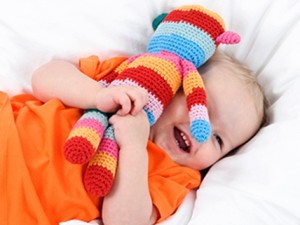Doll play – Baby
 Including dolls in play with your baby can help build early communication skills. This includes taking turns, following your baby’s lead, copying their actions with the doll and keeping it simple.
Including dolls in play with your baby can help build early communication skills. This includes taking turns, following your baby’s lead, copying their actions with the doll and keeping it simple.
Did you know?
Babies are attracted to faces so dolls can be a perfect comfort object.
Add language
Provide the words that go with what your baby is focused on or doing with the doll e.g. ”cuddle dolly”, “dolly soft”, “Dolly’s eyes”.
Help to develop your baby’s language by using the doll to play peek-a-boo, repeating the same word or phrase as you play e.g. “Where’s dolly?” or “Boo”.
Ask occasional questions that can be answered by baby even before they can use words i.e. simple yes/no questions they can shake or nod their head to e.g. “Is dolly hungry?” or simple “where” questions that they can use pointing or gesture to answer e.g. “Where’s dolly’s nose?”
Other development
Soft dolls provide your baby with practice at grasping objects with their hands. Smaller soft dolls are more manageable for babies than large, heavy dolls.
Variations
Given that babies can become very attached to their soft doll or animal toy it can be helpful if washable toys are chosen to give to your baby.
Safety
Check that the doll has no small parts that can become loose and no cords that can be choking hazards.
Across the ages
All the activities listed on our “Play Ideas” page can be applied across different age groups. Check out doll play for toddlers, children and playgroups.
Activities listed under “baby” are suitable for children under 12 months. This age is largely about babies exploring their own bodies and the world around them from the safety of a close relationship with their caregiver.

